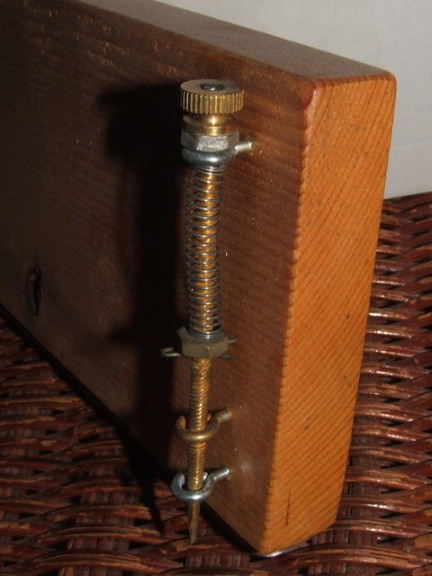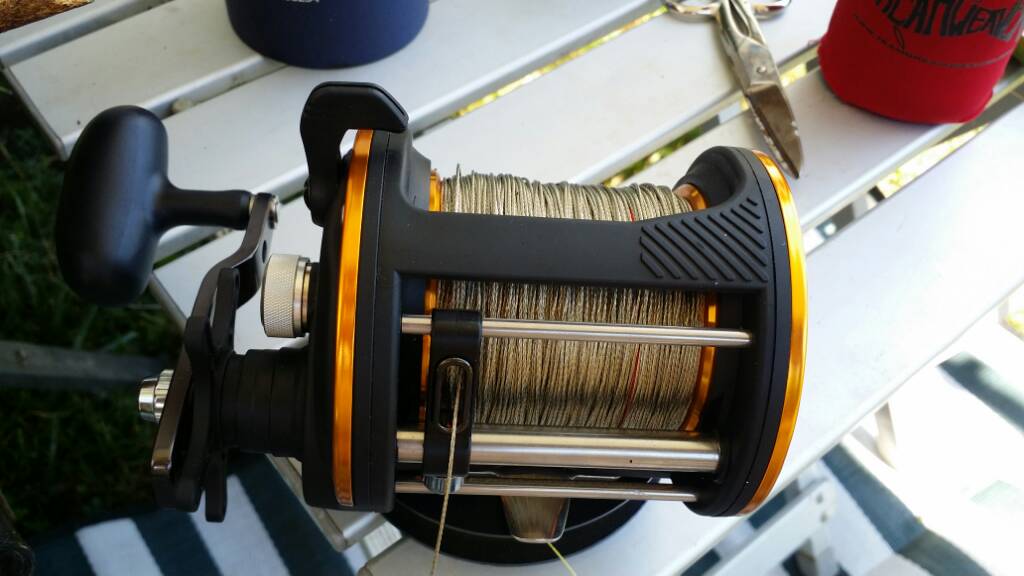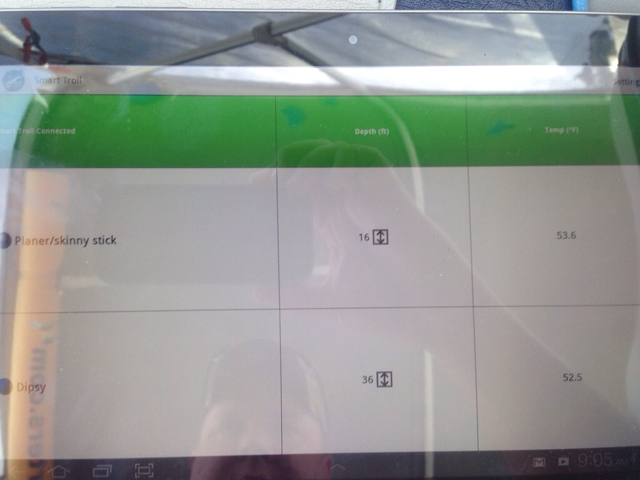

bloodrun
Members-
Posts
47 -
Joined
-
Last visited
Content Type
Profiles
Forums
Events
Gallery
Store
Everything posted by bloodrun
-

Four wire diver rods on L.O.-is it worth it?
bloodrun replied to Mike M's topic in Questions About Trout & Salmon Trolling?
Aside from being the most productive rods in the water for us for more than a decade, wire divers tell us so much more about what currents are doing as well, and create a harmonic that cannot be duplicated by any other presentation. I would run down the dock in a thong before NOT running 4 wire divers (sometimes 6) at all times. Spinnies and flies on all of them from June through September. -
we used to think it was the be-all end all. Still have one and run it once in a while. Once we figured out how to catch kings in 70 degree water and read our speed watching our wire divers, we stopped relying upon it. Nice to know information, not need to know unless maybe you are tournament fishing and need to keep up with a moving pocket of down water that is holding fish you are fishing for.
-
Even with OR-18's or Lock Jaws..eventually line will slip, particularly braid. We switched over to metal pins in the back of all our Church's and now when we put the line behind the pin, we spin the entire board around two or three times before we put the line in the release. In the event the line comes out of the release, the board stays on the same place on the line. Additionally, the board will never again slip down the line because of the line slipping through the release. The "spin on the pin" keeps it stationary. Won't work on stock pins as the line will cut a groove in the plastic and you cannot pull the pin up when you are bringing a board in. Have heard good things about the Offshore Snapper Adjustable tension release, but again, any line will eventually cut through the rubber pads and your line will no longer hold inside the release.
-
We have used quite a bit of 32, 45 and 60lb...The majority of what we use now is back to all 32lb (which is where we started many years ago). We have a couple of 200' 60lbs which are by far our best overall, but you can't beat the smooth deployment and greater capacity of the 32lb. If you keep your boards spaced out good, you should have no problem mixing different copper sizes. We use all Church walleye boards with the weight pushed forward for our 35'-150' coppers. Everything from 200' and beyond gets a Church TX-44 with the weights pushed forward also. Our boards get out real wide with great spacing, even on super long meat rig paddled setups 500+. We typically run 4 boards a side and have started loading up with multiple reels of the same segment. Fishing is getting a little tougher the past year or two, and when fish are biting on a certain length, we will put out 4 to 6 of them at a time. It has paid huge dividends.
-
From what I have seen, you still have to deploy the same amount of line to get to the depth you want. The only difference is instead of letting out 300 feet of copper and reaching your depth, you would let out 200 feet of copper, 100 feet of backer, and then snap this thing on and they say you would be at the same depth. In my experience these work good running lots of shallow lines trolling for walleye, like the top 20 maybe 30 feet. Once you get deeper with long coppers, heavy currents, big paddles and flashers....they dont work and they tangle like crazy with gear next to it. They get dragged around in the current and will inevitably swing into nearby coppers or divers.
-
Blood Run
-
There are some tricks to the TX-44, and inlines in general. For all inlines, fighting a fish should have the rod pointed horizontally or into the water. Rod tip down, board nose up.....right up to the point that you lift the board out of the water. There is no pumping of inlines, just brute force shoulders down reeling. You actually are using the board for leverage against the fish. Second tip (for the TX-44). You HAVE to put the pin on the bottom, and clip your line in the bottom slot. These boards are designed to be either port or starboard. In either case, you have to use the bottom slot for your line, and the pin must pull down towards the water. Third tip on the TX-44. Take the weights out of the board, cut a slot in the foam which will allow you to double stack the weights slightly forward of center. Drill new holes in the bottom through the stacked pieces of lead, and screw the screws back into these stacked pieces. Your TX-44 will now pull 30 degrees further up the side of your boat then they previously did, and will pull much more effortlessly, and will be easier to retrieve. If for some reason you have an inline board dive, stick the rod tip into the water and open the bail on the reel and slowly allow line to peel off the reel while thumbing it. The board will quickly pop back up to the surface. Re-engage the bail and start your retrieve again, with your rod tip pointed into the water.
-
Don't be afraid to use inlines. Here is a picture of our spread with the three outside coppers on Walleye Boards, and two closest coppers on TX-44's. We have not had to fish super deep this year, but in years past this same spread can be run with 450-600's, however only using TX-44's. http://instagram.com/p/qBrfCFHlWt/?modal=true
-
We have had pretty extensive useage of the system, and while not perfect, it does what it intends to do. Probably the only issue that we have on occasion is RPM interference on the signal. But, we are trolling a 454 with bags on both sides of the boat and are pushing 1000 rpms all the time. When we drop a bag, and troll with the motor on the opposite side of the boat that the transducer is mounted, we get flawless readings (under about 700 rpm). You have to get use to the numbers "settling in". The new upgrade to the probes increases the communication frequency between probe and transducer, so you wait less time for updated readings..a few seconds instead of sometimes several. The information provided however cannot have a price put on it, extremely valuable in our opinion. The technology will only get better, and yes Darrell is behind it 100%. Great guy and great customer service.
-
Blood Run Tackle, LOU site sponsor as well. Also selling pre-loaded Tekota's (and other reels) on their website at http://bloodruntackle.gostorego.com/salmon-fishing-line-downrigger-leader-wire-copper-trolling/pre-spooled-shimano-tekota-800-copper-fishing-wire-line.html
-
http://www.bloodruntackle.com/wp-content/uploads/2013/05/CopperDiveChart.pdf and the android app http://www.bloodruntackle.com/BloodRunTackle.apk Should give you a rough idea at least up to 2.5 gps speed. Alot depends on down speed/currents also. These numbers are with a spoon only.
-
Not at the moment, as discussed above 3.0 is way out of most guys comfort zone for walleye, though it is deadly! I will ask and find out if there are plans, there are a number of folks coming out of the closet regarding fishing at those higher speeds, even spinner guys! The walleye copper is fairly small diameter and that may help against "lift" at higher speeds compared to larger dia lines (core, 45lb copper, etc).
-
Have caught alot on lead too..but we have far more success now with copper. Just reporting what we saw with the smarttroll and fishawk td. There were numerous other folks that saw the same thing. We did stop once and lead finally sunk. Does not even come close to the sink rate of copper though. Here are the leadcore numbers at 2.5 gps with a spoon in the first column. Second column is Walleye copper depths at the same amount of line out also with a spoon. 2.0 speed number are even more dramatic. Copper is heavier than lead by a wide margin. 1 color - 2' - 4' 2 color - 7' - 9' 3 color - 9' - 14' 4 color - 11' - 17' 5 color - 14' - 22' 6 color - 18' - 28' 7 color - 21' - 34' 8 color - 24' - 38' 9 color - 29' - 43' 10 color - 37' - 51' Leadcore flatlined from 10 to 20 colors....approx 37 feet the whole way out at 2.5 gps. Copper kept on sinking. Same measurement tool was used for both.
-
Blood Run is testing a 20lb version of the Sea Flee line this season, as well as introducing a new "Niagara Green" color in June (in 30lb test). This line did the trick last year on Lake O and the Finger Lakes. Be sure to wrap 7 times on a Blacks release...the line is pretty slick. The line could be difficult to get ahold of for a while, Narby's, All Season's and Fat Nancy's are the only dealers in stock at the moment.
-

Please Educate Me on Using Big Boards...
bloodrun replied to VanderLaan's topic in Tackle and Techniques
Capt Rob is correct. You will find in general that Lake O guys usually pull one to three copper max around the entire boat during the summer. One down the chute and maybe one per side. A few guys pull more. It was until fairly recently they got 3 rods per man, but I think their limits are only 3 salmon per angler, below 5 per man like in Michigan. So, Michigan guys pull more rods, which is why you see 3-4 boards per side as a norm. It is not efficient at all to pull all the same length of copper on one side of the boat off a big board, you will just completely miss fish higher and lower in the water column throughout the bite periods. One of the advantages of pulling so many different lengths of copper is quickly identifying hot segments in the water column during a given outing, and not having to just rely on riggers or divers to tell you that. There is no way to mix different length coppers off big boards and not get tangles. Short always goes out the furthest, longer closer to the boat. Frequently on Lake MI we will have multiple segments on fire throughout different periods of a given morning, and only inline boards give us the flexibility to do that. It is not uncommon to have 150's firing early only to have the 350's and 450's explode later in the morning. Taking advantage of a versatile spread with multiple segment lengths will almost always result in more activity. -
Have always used snubbers..running 4 wire divers. Three weeks ago we lost one and fished without it. Had better hookup ratios and more feel for the fish imo. We took the rest of our snubbers off. Our diver rods and reels (talora and tekota) are REALLY broken in, so they probably absorb some of the shock. We stepped up to 40lb fluoro leaders as well, so I can't think of what might break in whole equation. So far so good!
-
30lb Fluoro for divers and coppers...both spoons and flashers. 40lb for flies. We have seen no difference in our program between 20lb and 30lb, other than 20lb will break on a diver hit most times, even with a snubber. Fluorocarbon creates intense friction when tightened down at the knot unless lubed. Make sure you are not burning up your knots when you do tie them. All of our pro staff that use our 20lb fluoro go through insane amounts of it, due to frequent re-ties. The smaller diameter material is just that, smaller. It can handle only so much abuse before it needs to be cut back in order to avoid a break off. We can run 30lb for multiple seasons with rare cutbacks. Either way...yes it does make a difference! And it is not just the visibility properties of it, it is in fact the stiffness and abrasion resistance that makes it a more durable and action generating material for flies and spoons. Fluorocarbon also has an unlimited life span, it will not degrade over time like a mono will.
-

Leadcore sink rate flatlinning after 50-60' ?
bloodrun replied to mcny's topic in Questions About Trout & Salmon Trolling?
There were some depth measurement tests done a couple of weeks ago on 27lb leadcore using a SmartTroll. All of the different coppers were successfully measured in depth out to 500+ feet of line. When the leadcore was measured, it failed to produce a reading beyond 10 colors of lead at 2.5gps speed. The leadcore flatlined out behind the boat and the transducer could no longer communicate with the depth measurement probe. When reeled back in from 11-20 colors of lead, the readings then began again. The theory, as discussed often by many, is that leadcore suffers from the scuba diver effect, whereas scuba divers must attach heavy lead weights to themselves proportionate to their own body weight, in order to be able to dive down to certain depths and maintain at those depths. Any less weight and the diver rises back up, or fails to reach the desired depth in the first place. Dacron sheath leadcore absorbs water and when working in conjunction with the lead "core" becomes neutral buoyant around 40 feet down, on a straight line troll at 2.5 gps speed. If you stop, or turn, leadcore will sink eventually to the bottom, albeit slowly. But under "tow" at trolling speed...37' was the deepest the readings were able to produce no matter how much leadcore was deployed beyond ten colors. We actually tested this theory a number of years ago based upon a similar discussion. We put out a 20 color and cut across the back of our boat at an estimated 500-600' distance with another boat and regularly "caught" the 20 color with our downrigger....set at 40 feet. -
The line is called Sea Flee, and is a 30lb Test Dia mono with super slick silicone compound embedded into the mono to make the surface of the line more slippery to help against flea build up, combined with the larger diameter. I would not use the tournament mono in heavy flea situations. The diameter of the tournament mono is only of 16lb test, though breaking strength is 25+.
-
It was brought to market specifically for Lake O anglers. However, as this discussion continues on, do not forget how many fish you have caught on your 200, 300, 400 coppers. Why? It shows a pattern of kings having no issue with rising to strike a high presentation, regardless of water temp. On Lake Michigan we regularly catch kings in 65 degree water. The poster above who mentioned that this should translate to rigger hits up high as well...not the case. Kings feed on presentations at different layers of the water column for different reasons at different times. That is why you need a big spread of all three...wire divers, riggers and coppers. Various times within the day, kings will pick out one of these presentations..but not others. Sometimes they want all three, sometimes two, sometimes just one of them. Whatever they want for that day, or at that time, you should have as many of them out there as possible. Don't focus on the depth, focus on the fact that they are picking out that presentation at that layer and put more of it out. We run three divers a side when they are hot on divers. We run 5 coppers a side when they are hot on coppers. We cycle multiple rigger rods when the rigger bite is hot. Adapt throughout the day and you will double or triple your catch.
-
The tests were done primarily with Blood Run, though we wanted to debunk the myth of different brands of copper running deeper. So there was a Morgans copper and Atomik copper also pulled to verify. All three brands of copper ran within 2 feet of each other at various depths. There was no current, no thermocline as well.
-
We ran the 60lb last year quite a bit, it is a gradual deployment at 2.5 gps speed and we had no issues sliding it way out on an inline over two wire divers run out 400 on a 1 and 3 setting. This isn't like a torpedo or dive bomb that takes the line straight down causing tangles on deployment if not watched carefully. Set it and fish it like 45lb..
-
The most typical way of attaching your line to your planer board when pulling either leadcore or copper is to let ALL of your leadcore or copper out that you have spooled up on the reel. Let another 20-30 feet of backer out and then pinch your backer line into the release on the planer board. Some also attach a rubberband to keep braid from slipping in the planer board release. We use backer mono which does not slip, so no rubberband is required. You would need to decide what your ideal targeted depth would be for that reel, and spool up the appropriate amount of copper or leadcore to reach that desired depth at your average trolling speed. You cannot snap a planer board release directly on to copper or leadcore, both will wear quickly and then break.





